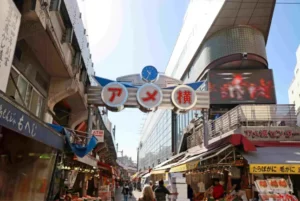
A Perfect Autumn Walk from the Ginkgo Tree Avenue to Meiji Shrine and Harajuku
Kawasaki offers excellent access not only to Haneda Airport and Yokohama but also to central Tokyo. It's easy to visit areas like Aoyama and Harajuku. This time, we will guide you from the popular autumn spot, the Ginkgo Tree Avenue at Meiji Jingu Gaien, to Meiji Shrine and the Harajuku area. Enjoy breathtaking autumn views, visit one of Tokyo's top power spots, and relax in a tranquil, cozy traditional café while experiencing the diverse faces of the city.
Outline
Access from the Hotel to Ginkgo Tree Avenue in Meiji Jingu Gaien
From JR Tōkaidō Line “Kawasaki” Station, take the train to “Shimbashi.” Transfer to the Tokyo Metro Ginza Line and get off at “Aoyama-itchome.” It’s an 8-minute walk from there.
Estimated time: Approximately 40 minutes.
Capture the Perfect Shot at the Scenic Photo Spot, Meiji Jingu Gaien Ginkgo Tree Avenue

The Meiji Jingu Gaien Ginkgo Tree Avenue, which stretches straight from the Aoyama-dori entrance to the central circular road of the Gaien Plaza, is a must-visit autumn attraction. From mid-November to early December each year, 146 ginkgo trees turn golden, creating a stunning 300-meter-long avenue bathed in golden hues.

When you look up, the entire area is filled with dazzling golden yellow! Even staff members visiting for the first time during the autumn foliage season couldn’t help but stop and be captivated. It seems the beauty was beyond their expectations…!

On sunny days, the contrast between the blue sky and the golden yellow is striking, creating a vibrant scene. There are endless opportunities for the perfect shot!
Moreover, to make the most of this breathtaking view…

I gathered fallen leaves and captured a shot that looked like a scene straight out of a movie or drama.
Meiji Jingu Gaien was created in 1926 to pass down the legacy of Emperor Meiji and Empress Shoken to future generations. In addition to the ginkgo tree avenue, the grounds feature the Meiji Memorial Picture Gallery, which is designated as an Important Cultural Property, as well as the Meiji Kinenkan, where you can enjoy restaurants, cafes, and a Japanese garden. If you want to appreciate the harmony of nature and historic architecture, taking a leisurely stroll around the area might be a great idea.
Meiji Jingu Gaien Ginkgo Tree Avenue
Address: 2 Chome Kita-Aoyama, Minato City, Tokyo
Website: Meiji Jingu Gaien Website
Visit the Richly Natural Forest of Meiji Shrine, Tokyo’s Top Power Spot for Praying for Good Fortune

Next, we head to Meiji Shrine. While the ginkgo tree avenue is located in the “Gaien” (Outer Garden), Meiji Shrine is situated in the “Naien” (Inner Garden). It was established in 1920 with the purpose of enshrining Emperor Meiji and Empress Shoken.
From the Meiji Jingu Gaien Ginkgo Tree Avenue to the Harajuku entrance (South Main Shrine Path), it’s about a 10-minute taxi ride. If walking, it takes around 30 minutes.

First, take a 15-minute walk from the Harajuku entrance to visit the main shrine. The vast grounds, covering approximately 700,000 square meters (about 15 times the size of Tokyo Dome), offer plenty of walking opportunities.
One notable feature here is the “Meoto Kusu” (Couple Camphor Trees) that stand majestically on either side of the main shrine. These trees are known as a power spot for matchmaking, marital harmony, and family safety, offering blessings to those who visit.

The Ema (votive plaques for prayers, ¥500) can be hung at the Ema rack located next to the Meoto Kusu on the right side. This is a very auspicious spot, where words of prayers, gratitude, and vows seem likely to come to fruition.

This is the “Kaiun Mokurin Kodama” (Good Fortune Bell, ¥1,000). It is made from the sacred trees within the shrine grounds, and the word “Kaiun” (Good Fortune) is engraved on the back. It’s a souvenir unique to Meiji Shrine, made from the 36,000 trees that make up the shrine’s forest.

The Omikuji “Ōmigokoro” (Great Heart) is not a typical fortune-telling that predicts good or bad luck, but rather a unique feature of Meiji Jingu. It contains waka poems written by Emperor Meiji and Empress Shoken, the enshrined deities. Emperor Meiji left approximately 100,000 poems, and Empress Shoken wrote about 30,000. From these, 30 poems that offer life lessons are selected, with 15 poems from each. Each poem is accompanied by an explanation, and 20 of the poems also have English translations.

This is a popular spot for foreign tourists the sake “Komodaru” (straw-wrapped sake barrels). Empty containers of sake donated from all over Japan decorate the South Main Shrine Path. The unique characteristics of each brand are beautifully displayed in the limited space, offering a fascinating and engaging view that even locals find interesting. I couldn’t help but stare at them for a while.

When you turn around from the sake barrels, the scenery changes completely. You’ll encounter the rare sight of wine barrels lined up in a corner of the shrine. It is said that because Emperor Meiji was fond of drinking wine, wines from the Burgundy region of France are still dedicated here today.

Be sure to also pay attention to the “Second Torii Gate” where the South and North Main Shrine Paths meet. Standing 12 meters tall, 17.1 meters wide, and with pillar diameters of 1.2 meters, this wooden torii gate is the largest in Japan. Weighing a staggering 13 tons, it was crafted from a giant tree over 1,500 years old.
For those looking to further enjoy Meiji Shrine and explore power spots, we highly recommend visiting the Meiji Jingu Gyoen (Entrance Fee: ¥500 for adults, ¥200 for elementary and middle school students).

In the Edo period, the vast garden of 83,000 square meters was the residence grounds of the Kato and Ii families. After the Meiji Restoration, it became a royal property and a famous garden associated with Emperor Meiji and Empress Shoken. The 1,500 irises, which bloom in June, were planted under the direct instruction of Emperor Meiji. Today, they have become a symbolic feature of Meiji Jingu Gyoen. Along with the irises, the stunning autumn colors of the maple trees can be enjoyed from late November to mid-December.
One of the power spots within the Meiji Jingu Gyoen is the Kiyomasa’s Well (Kiyomasa no Ido).

This is one of Tokyo’s most famous wells, believed to have been dug by Kato Kiyomasa during the time when the Kato family resided here. The well continually springs forth 60 liters of pure water per minute throughout the year, and it is said to have a purifying power.

The staff couldn’t help but bow in front of the mystical well, as the water flows continuously. Let’s hope it brings blessings!

Additionally, near the North Main Shrine Path, there is a park-like space where you can enjoy views of the Shinjuku cityscape. The more you walk, the more you can expect to experience the rich nature and numerous blessings of Meiji Shrine. It is definitely a spot that promises a fulfilling journey.
Meiji Shrine
Address: 1-1 Yoyogi Kamizono-cho, Shibuya, Tokyo
Phone: 03-3379-5511 (Main)
Opening Hours: Opening and closing times vary by month. Please refer to the website.
Website: Meiji Shrine Website
Relax with High-Quality Coffee and Aesthetic Ambiance at “Café Un Seuil d’Angle Harajuku”

The last spot we’ll introduce is “Café Un Seuil d’Angle Harajuku”, marked by a wooden sign and a red pot.

Descend the stairs to the basement, and when you open the door…


Despite being in the lively Harajuku area, a quiet and serene space unfolds before you.

“Café Un Seuil d’Angle Harajuku” is a long-established café that will celebrate its 50th anniversary in 2025. The unique atmosphere is evident in the carefully selected furnishings, which exude a distinctive charm.

A luxurious moment enjoying “Blended Coffee” (¥680) and “Gateau Fromage” (Homemade Cheesecake, ¥570) at the counter. The main cups used are said to be from Royal Copenhagen.
The coffee has a rich flavor with a refreshing aftertaste, while the Gateau Fromage has a gentle texture with a strong, yet delicate, taste of cheese. Simple yet unforgettable in its deliciousness.

The coffee, reputed to impress even the most dedicated coffee enthusiasts, is brewed using the Nel Drip method. It is made with “Aged Coffee”, which is created by resting green beans in a well-ventilated space for about two years.

The Croque Monsieur (French-style open sandwich, ¥800) is made with the owner’s homemade béchamel sauce, perfectly complemented by the subtle sweetness of the bread. The high-quality dishware further enhances the satisfaction of the meal.

The beauty of the space can be felt until the very end, and just before leaving the café, I found myself thinking, “I wish I could stay a little longer.”

On the way back to JR Harajuku Station, I passed through the entrance of Takeshita Street, which was crowded with people, and thought, “I’ve finally returned from the dream to reality…” That’s how comfortable and welcoming the café was.
Un Seuil d’Angle Harajuku
Address: 3-61-11 Sendagaya, Shibuya, Tokyo
Phone: 03-3405-4482
Hours: 10:00 AM – 9:00 PM
Closed: Open every day




